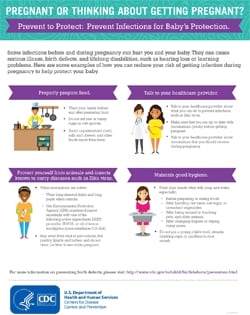
Prevenga las infecciones para proteger al bebé

Algunas infecciones que tienen lugar antes y durante el embarazo pueden causarles daño a usted y a su bebé. Aprenda a protegerse de los animales y los insectos que se sabe que transmiten enfermedades, como la provocada por el virus del Zika.
Algunas infecciones que tienen lugar antes y durante el embarazo pueden causar enfermedades graves, defectos de nacimiento y discapacidades permanentes, como la pérdida auditiva o problemas de aprendizaje. Las mujeres pueden disminuir el riesgo de tener un bebé con un defecto de nacimiento si siguen algunas pautas básicas para el cuidado de la salud durante sus años reproductivos. Esto es importante porque muchos defectos de nacimiento ocurren muy temprano en el embarazo, a veces antes de que una mujer sepa que está embarazada. Alentamos a todas las mujeres y a sus seres queridos a “prevenir para proteger”: prevenga las infecciones para proteger al bebé.
Cómo protegerse de los animales e insectos que se sabe que transmiten enfermedades
- Use repelentes de insectos: Los mosquitos propagan muchos tipos de virus que pueden causar enfermedades como el zika. Para protegerse, use en la piel los repelentes de insectos registrados por la Agencia de Protección Ambiental (EPA), que contengan uno de los siguientes ingredientes activos: DEET, picaridina, IR3535 o aceite de eucalipto de limón.
- Use camisas de manga larga y pantalones largos cuando esté afuera: Cuando sea posible, use mangas largas y pantalones largos como protección adicional contra las picaduras de insectos. Los mosquitos pueden picar a través de la ropa delgada, así que impregne la ropa con permetrina u otro insecticida registrado por la EPA para una mayor protección.
- Manténgase alejado de los roedores silvestres o los que se tenga como mascotas, y de sus excrementos.Contrate a un profesional de control de plagas para eliminar las que haya en su hogar o alrededor. Si usted tiene un roedor mascota, como un hámster o una cobaya, pídale a otro familiar o amigo que cuide a la mascota y limpie la jaula hasta que nazca el bebé. Algunos roedores pueden portar un virus dañino. Obtenga más información sobre el virus de la coriomeningitis linfocítica (LCMV).
- No limpie la arena de la caja sanitaria del gato durante el embarazo: Los gatos pueden propagar toxoplasmosis, un parásito que puede ser transmitido a su bebé. Evite cambiar la caja de arena del gato mientras esté embarazada. Si nadie más puede hacerlo, use guantes desechables y lávese las manos después, con agua y jabón.
Actividades de los CDC: Defectos de nacimiento
Los CDC trabajan para identificar las causas de los defectos de nacimiento, encontrar oportunidades para prevenirlos y mejorar la salud de las personas que los tienen.
- Seguimiento: Los CDC están haciendo un seguimiento de la propagación del virus del Zika y estudiando los vínculos entre el zika y los defectos de nacimiento. Además, los CDC proveen fondos a 14 estados para que hagan el seguimiento de los defectos de nacimiento graves. Los estados utilizan los datos para guiar las actividades de prevención de defectos de nacimiento y remitir a los niños con estos defectos a los servicios disponibles.
- Investigación: Los CDC proveen fondos a los Centros de Investigación y Prevención de Defectos de Nacimiento, que colaboran en estudios de gran escala como el Estudio Nacional de Prevención de Defectos de Nacimiento* (nacimientos de 1997 al 2011) y el Estudio sobre Defectos de Nacimiento para Evaluar las Exposiciones durante el Embarazo,* también llamado BD-STEPS, (que comenzó en el 2014). Los investigadores de estos estudios trabajan para identificar los factores que pueden aumentar o disminuir el riesgo de tener un bebé con un defecto de nacimiento. Otras investigaciones de los CDC se centran en el uso de los servicios de salud y las consecuencias a largo plazo en la salud de las personas que tienen defectos de nacimiento, como también los costos asociados a estos defectos.
- Prevención: Los CDC y sus socios utilizan lo que aprenden a través de la investigación para prevenir los defectos de nacimiento.
- Ácido fólico: Tomar suficiente ácido fólico (una vitamina B) antes y durante las primeras semanas de embarazo reduce el riesgo de defectos de nacimiento graves en el cerebro y la columna vertebral, conocidos como anencefalia y espina bífida. La prevención de muchos de estos defectos de nacimiento se vio favorecida por una norma de 1996, por la cual se agregó ácido fólico a muchos alimentos.
- Atención médica antes de la concepción: Los CDC y sus socios también trabajan para educar a las mujeres sobre la importancia de la salud antes del embarazo, a través de la campaña “Demuestra tu Amor” (Show Your Love).*
- Mejorar la calidad de vida de las personas que tienen defectos de nacimiento: Los bebés que tienen defectos de nacimiento con frecuencia necesitan cuidados y tratamientos especiales para sobrevivir y desarrollarse. Los sistemas de seguimiento de defectos de nacimiento son una forma de identificar a niños y remitirlos a los servicios que necesitan lo más pronto posible. La intervención temprana (tratamiento para retrasos en el desarrollo físico y mental, y en el habla/lenguaje) es vital para ayudar a los bebés que tienen un defecto de nacimiento a alcanzar su máximo potencial.
* Los enlaces a sitios web pueden llevar a páginas en inglés o español.
Prevent Infections for Baby’s Protection | Features | CDC
Prevent Infections for Baby’s Protection

Some infections before and during pregnancy can hurt both you and your baby. Learn how to protect yourself from animals and insects known to carry diseases, such as Zika virus.
Some infections before and during pregnancy can cause serious illness, birth defects, and lifelong disabilities, such as hearing loss or learning problems. Women can lower their risk of having a baby born with a birth defect by following some basic health guidelines throughout their reproductive years. This is important because many birth defects happen very early during pregnancy, sometimes before a woman even knows that she is pregnant. We encourage all women and their loved ones to Prevent to Protect: Prevent infections for baby’s protection.
How to Protect Yourself from Animals and Insects Known to Carry Diseases
- Use insect repellents: Mosquitoes spread many types of viruses that can cause diseases such as Zika. To protect yourself, use Environmental Protection Agency (EPA) registered insect repellents on your skin that contain one of the following active ingredients: DEET, picaridin, IR3535, or oil of lemon eucalyptus.
- Wear long-sleeved shirts and long pants when outside: When possible, wear long sleeves and pants for additional protection against bug bites. Mosquitoes may bite through thin clothing, so treat clothes with permethrin or another EPA registered insecticide for extra protection.
- Stay away from wild or pet rodents and their droppings: Have a pest control professional get rid of pests in or around your home. If you have a pet rodent, like a hamster or guinea pig, have someone else care for it until after your baby arrives. Some rodents might carry a harmful virus. Learn more about lymphocytic choriomeningitis virus (LCMV).
- Do not clean cat litter boxes while pregnant: Cats can spread toxoplasmosis, a parasite that can pass to your developing baby. Avoid changing cat litter while pregnant. If no one else can perform the task, wear disposable gloves and wash your hands afterwards with soap and water.
CDC Activities: Birth Defects
CDC works to identify the causes of birth defects, find opportunities to prevent them, and improve the health of those living with birth defects.
- Tracking: CDC is tracking the spread of Zika virus and studying the links between Zika and birth defects. In addition, CDC funds 14 states to track major birth defects. State systems use the data to help guide birth defects prevention activities and refer children affected by birth defects to needed services.
- Research: CDC funds the Centers for Birth Defects Research and Prevention, which collaborate on large studies such as the National Birth Defects Prevention Study (births 1997-2011) and the Birth Defects Study To Evaluate Pregnancy exposureS, also called BD-STEPS, (began in 2014). Researchers on these studies work to identify things that may increase or decrease the risk of having a baby with a birth defect. Other CDC research focuses on health services use and long-term health outcomes for people who have birth defects, and the costs of birth defects.
- Prevention: CDC and its partners use what they learn through research to help prevent birth defects.
- Folic acid: Getting enough folic acid (a B vitamin) before and during the early weeks of pregnancy greatly reduces the risk of serious birth defects of the brain and spine known as spina bifida and anencephaly . A 1996 policy to add folic acid to many foods helps to prevent many of these birth defects.
- Preconception care: CDC and its partners also work to educate women about the importance of preconception (before pregnancy) health through a campaign called Show Your Love.
- Improving the lives of individuals with birth defects: Babies who have birth defects often need special care and treatment to survive and thrive. Birth defects tracking systems provide one way to identify and refer children for services they need as early as possible. Early intervention (treatment for delays in physical and mental development, and in speech/language) is vital to help babies born with a birth defect reach their full potential.


































No hay comentarios:
Publicar un comentario